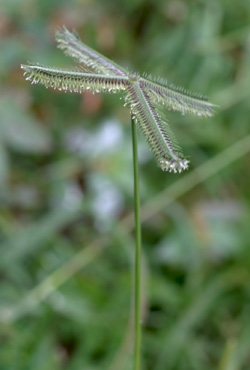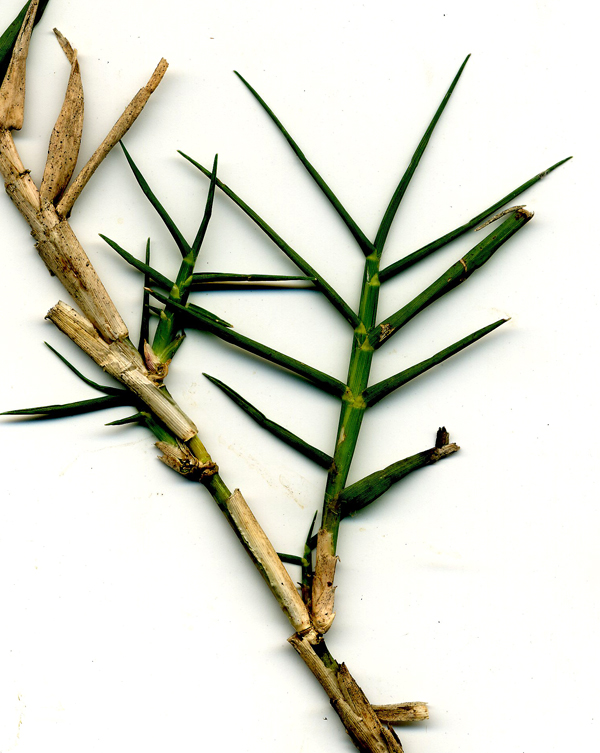|
40a |
( 26 26
&
 38) 38) |
 Inflorescence an umbrella like arrangement of (1-)3-9 spikes. Each spike with two rows of downward-pointing bristled spikelets appearing like teeth on a comb. Rachis usually extending as a conspicuous point beyond last spikelets. Ligule a fimbriate membrane. { Widespread although typically not abundant where found; small running grass (Fig. 12B). Beach wiregrass [HAW - NAT] crowfoot grass [GUM - NAT]
Inflorescence an umbrella like arrangement of (1-)3-9 spikes. Each spike with two rows of downward-pointing bristled spikelets appearing like teeth on a comb. Rachis usually extending as a conspicuous point beyond last spikelets. Ligule a fimbriate membrane. { Widespread although typically not abundant where found; small running grass (Fig. 12B). Beach wiregrass [HAW - NAT] crowfoot grass [GUM - NAT] Dactyloctenium aegyptium (L.) Willd.
Figure 12B. Beach wiregrass (Dactyloctenium aegyptium) inflorescence of spikes arranged with the spikelets pointing downward and comb-lkike due to bristles.
|
|
|
|
40b
|
|
Inflorescence of spikes or racemes, with or without bristles, but not comb-like in appearance, the spikelets tending to lay flat against the rachis, the tip of which is hidden by uppermost spikelets .. .
|
|
[41]
|
|
~~~~ ~~~~~~~~~~~~~~~~~~~~~~~~~
|
|
|
41a
|
(40) |
Spikelets with awns (bristle-like narrow appendage arising near the upper end of one or more bracts of the spikelet) and at least as long as the supporting bract. (Note: true bristles are stiff hairs arising from the base of the spikelet, not from within the spikelet).
|
|
[48]
|
|
41b
|
|
Spikelets without awns or awns very short (less than length of the bracts surrounding the floret) and not conspicuous even with low-power magnification
.. .
|
|
[42]
|
|
~~~~ ~~~~~~~~~~~~~~~~~~~~~~~~~
|
|
|
42a
|
(41) |
Inflorescence of 3 to 20 coarse spikes or racemes. Small to medium spreading or clumping grass
|
|
[43] |
|
42b
|
|
Inflorescence of 3 to 9 delicate, narrow spikes or racemes. Small grass spreading by stolons or rhizomes or both
|
|
[45] |
|
~~~~ ~~~~~~~~~~~~~~~~~~~~~~~~~
|
|
|
43a
|
(42) |
Spikelets 3+ mm long. Small to medium clumping grass.
|
|
[44] |
|
43b
|
|
Spikelets 3 mm or less in length. Course, medium, spreading grass. Ligule a dense fringe of hairs
|
|
[47] |
|
~~~~ ~~~~~~~~~~~~~~~~~~~~~~~~~
|
|
|
44a
|
(43) |
Inflorescence digitate, but often with one raceme located on culm an inch or two below the 2-6 clustered racemes. Spikelets nearly 1/4 inch (5-7 mm) long, appearing coarsely toothed, but not awned and greatly overhanging the rachis. Culms expanded at base, conspicuously flattened. { Small, coarse, annual clumping grass, typically as a weed, prostrate in mowed lawns, but upright where not so disturbed. Wiregrass [HAW - NAT], umog, goosegrass [GUM - NAT]Eleusine indica (L.) Gaertn.
|
|
|
44b
|
|
Inflorescence of (5-)7-20 spikes. Spikelet with several short awns, the longest about as long again as a spikelet, the shortest very short and on the upper glume. { Medium perennial grass of open, disturbed areas, verges, and pastures (Fig. 12A). (See also couplet [48a]) Rhodes grass [HAW - NAT] [GUM - NAT]
|
|
|
~~~~ ~~~~~~~~~~~~~~~~~~~~~~~~~
|
|
|
45a
|
(42) |
Spikelets narrowly ovate with one or more awns. Leaf arrangement distinctly alternate. Some Chloris spp.
|
|
[50] |
|
45b
|
|
Spikelets ovate, broadly or not, but without awns. Leaf arrangement alternate or distichous (two-ranked; alternating blades coming off culm in two vertical rows on opposite sides of the axis)
|
|
[46] |
|
~~~~ ~~~~~~~~~~~~~~~~~~~~~~~~~
|
|
46a
|
(45) |
 Inflorescence of usually 3-6(-9), stiff, thin spikes. Spikelets sessile, broadly ovate, compressed, without awns, falling without glumes and under 1/16 in (3.5-4.5 mm) long. Leaf arrangement distinctly distichous (Fig. 12C, left), especially on short, vegetative stalks. { Small (but quite variable in size), perennial grass spreading by stolons and rhizomes, widely used as a lawn grass (Fig. 12D). Bermuda grass, mānienie [HAW - NAT] Bermuda grass, grama [GUM - NAT]
Inflorescence of usually 3-6(-9), stiff, thin spikes. Spikelets sessile, broadly ovate, compressed, without awns, falling without glumes and under 1/16 in (3.5-4.5 mm) long. Leaf arrangement distinctly distichous (Fig. 12C, left), especially on short, vegetative stalks. { Small (but quite variable in size), perennial grass spreading by stolons and rhizomes, widely used as a lawn grass (Fig. 12D). Bermuda grass, mānienie [HAW - NAT] Bermuda grass, grama [GUM - NAT] Cynodon dactylon (L.) Pers.
|
|
|
46b
|
|
Spikelets narrowly ovate, pediceled, pedicels unequal, spikelets falling at maturity with glumes. Leaf arrangement distinctly alternate. Some Digitaria spp.
|
|
[36] |
|
~~~~ ~~~~~~~~~~~~~~~~~~~~~~~~~
|
|
|
47a
|
(43) |
Culms soft, not woody. Inflorescence of 3-13 spikes in one whorl (sometimes two). Spikelets single, on short pedicels borne alternately on either side of a flatened, curved rachis. African Bermuda grass [HAW - NAT]Cynodon nlemfuensis Vanderyst
|
|
|
47b
|
|
Culms stiff, "woody". Inflorescence of 5-17 spikes in one or (usually) two to five whorls. Giant star grass [HAW - NAT] Cynodon aethiopicus Clayton & J.R. Harlan
|
|
~~~~ ~~~~~~~~~~~~~~~~~~~~~~~~~
|
|
|
48a
|
[41] |
Spikelets under 6 mm (1/4 in) and crowded or not on the rachis of the raceme. Unequal glumes remaining on the rachis after the spikelet falls away .. .
|
|
[49] |
|
48b
|
|
Spikelets large (to 13 mm or 1/2 in) and so dense on a rachis at maturity that the rachis itself is obscured. Racemes may curve inward at tips. Spikelets not disarticulating at maturity. { Resembles the very common E. eleusine but much more robust; a large grass; seeds are exposed at maturity and edible; plant is grown as a crop in parts of Africa and Asia. ragi, ragimillet [GUM - NAT] Eleusine coracana (L.) Gaertn.
|
| |
|
~~~~ ~~~~~~~~~~~~~~~~~~~~~~~~~
|
|
|
49a
|
[48] |
Spikelets strongly laterally compressed, linear or lanceolate in outline on short pedicels crowded in two rows on rachis. Lower lemma with a bent awn, twisted at the base. Glumes keeled. Ligule a fringed membrane .. .
|
|
[50] |
|
49b
|
|
Spikelets rounded or linear, not strongly compressed, on short or no pedicels. Glumes not keeled. Ligule a membrane or dense row of cilia. Chloris spp. .. .
|
|
[45] |
|
~~~~ ~~~~~~~~~~~~~~~~~~~~~~~~~
|
|
|
50a
|
[49] |
Medium-size, grey-green grass; plant densely pubescent. Racemes 3 to 6. Leaves slender. Rachis trigonous. Spikelets 3.3-4.8 mm long, inserted into alternating notches in the rachis. Tuft of short hairs at base of each spikelet. Apex of lower lemma bifid. { Abundant perennial grass of grasslands and savanna on Guam. [GUM - END] Dimeria chloridiformis (Gaud.) K. Schum. & Lauterbach
|
|
|
|
50b
|
|
Small to medium-size grass; plant glabrous or sparsely pubescent. Racemes paired, short. Leaves short. Rachis flat, glabrous on the margins. Spikelets 0.8-3 mm long. Lower lemma awn 7-9 mm long. Upper glume deeply forked. { Annual. Mostly found in ditches and fallow rice fields. [GUM - IND]Dimeria ornithopoda Trinius
|
|
|